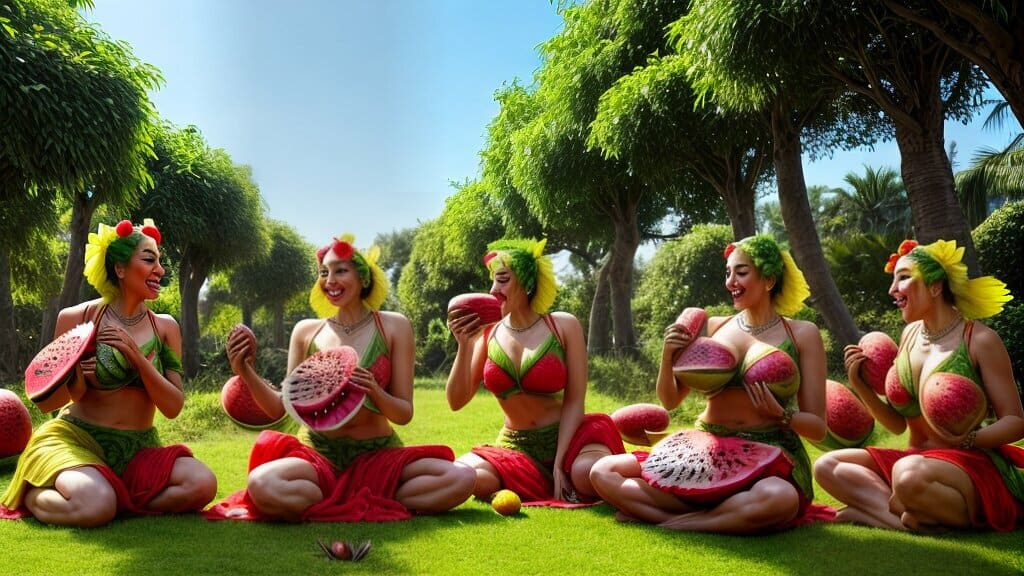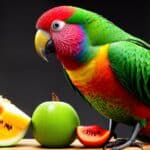Kakarikis are delightful birds that bring joy and energy to any avian enthusiast’s life. As caretakers, we need to ensure they are happy and healthy, including providing them with a balanced diet that meets their nutritional needs. One of the questions that arise is whether kakarikis can safely eat watermelon.
Can Kakarikis Eat Watermelon? Yes, Kakarikis can safely eat watermelon. This juicy fruit can be a refreshing and hydrating treat, especially during warmer months. However, removing the seeds before feeding is important, as they could potentially cause choking. Additionally, watermelon should be offered in moderation, as it is high in sugar.
In this section, we will explore the nutritional benefits of watermelon for our feathered friends, and answer the question of whether it is safe for them to consume. We will also provide tips on introducing watermelon to your bird’s diet and monitor its reactions.
Key Takeaways
- Kakarikis are delightful bird species that require a balanced diet to maintain their health and well-being.
- Watermelon can bring numerous nutritional benefits to your feathered friend, including boosting their immune system, enhancing their feather quality, and aiding digestion.
- Introducing watermelon to your bird’s diet gradually and in moderation, starting with small, bite-sized pieces is important.
Understanding the Kakarikis’ Diet
Before we dive into the topic of watermelon and kakarikis, it’s important to understand the dietary requirements of these adorable birds. Kakarikis have a varied diet that includes fruits, seeds, insects, and nectar. They require a balanced diet to thrive and maintain optimal health.
Fruits are an essential part of their diet. They provide vital nutrients such as vitamins, minerals, and antioxidants necessary for their well-being. In the wild, kakarikis feed on a variety of fruits, including native New Zealand fruits such as totara and kahikatea.
Seeds are also an essential component of their diet. In captivity, small seeds like millet and canary seeds can be fed to them in moderation. Larger seeds such as sunflower seeds should be offered occasionally as a treat.
Insects and nectar provide proteins and carbohydrates essential for their growth and energy requirements. In captivity, mealworms, waxworms, and crickets can be offered as a supplement to their diet.
It’s vital to offer a balanced diet to your kakariki. A lack of essential nutrients can lead to serious health issues such as feather plucking, weight loss, and poor immune function. Consult with a professional avian specialist to ensure that your kakariki’s diet is balanced and meets their nutritional requirements.
The Nutritional Benefits of Watermelon for Kakarikis
Watermelon is not only a delicious summer treat for us humans, it can also bring significant nutritional benefits to our avian companions, the kakarikis. This juicy fruit is low in fat and calories, making it an ideal bird snack. Additionally, watermelon is a rich source of vitamins and minerals that can contribute to the overall wellbeing of your feathered friend.
| Nutrient | Amount per 100g of Watermelon |
|---|---|
| Vitamin A | 28.6 mcg |
| Vitamin C | 8.1 mg |
| Potassium | 112 mg |
| Fiber | 0.4 g |
Vitamin A is essential for maintaining healthy eyesight, skin, and feathers in birds. Vitamin C is an antioxidant that can help boost the immune system, protecting kakarikis from diseases and infections. Potassium regulates blood pressure and supports proper muscle and nerve function. Finally, fiber aids in digestion and promotes a healthy gut.
As you can see, watermelon is a great addition to your kakariki’s diet, providing valuable nutrients that can contribute to their overall health and wellbeing. However, remember to introduce it in moderation and consult with a veterinarian or avian specialist if you have any concerns about your bird’s diet.
Introducing Watermelon to Kakarikis’ Diet
If you’ve decided to introduce watermelon to your kakariki’s diet, it’s essential to do so gradually and in moderation. Start by offering small, bite-sized pieces to observe how your bird reacts. It’s always best to consult with a veterinarian or avian specialist before significantly changing your bird’s diet.
When introducing new fruits to a bird’s diet, it’s important to note that their digestive system may need time to adjust. Overfeeding any fruit, including watermelon, can lead to digestive issues like diarrhoea and vomiting. Avoid feeding them large quantities at once, and ensure that they have access to fresh water at all times to aid digestion.
If you notice any signs of discomfort or abnormal behaviour after feeding your bird watermelon, stop feeding it to them immediately and seek professional advice. Allergic reactions to certain fruits are possible; knowing the signs could be life-saving.
Preparing Watermelon for Kakarikis
Before serving watermelon to your feathered friends, it’s essential to prepare it correctly to ensure their safety and enjoyment. Follow these simple steps:
- Choose a ripe watermelon: Ensure the watermelon is fresh, ripe, and free from any damaged or moldy areas.
- Remove the rind: Cut the watermelon into manageable pieces and remove the rind. The rind can be tough and difficult for kakarikis to eat, so it’s best to discard it.
- Eliminate seeds: Remove all the seeds from the fruit, as they can be a choking hazard or cause digestive problems for birds.
- Wash the fruit: Rinse the fruit thoroughly under running water to eliminate any potential pesticides or contaminants that could harm your bird. Dry the pieces with a paper towel to remove excess water.
By following these steps, you can offer your kakarikis a delicious and healthy summer treat that they will love. Remember to introduce watermelon gradually and in moderation, monitoring their reactions closely.
Watching for Potential Risks and Allergies
While watermelon is generally safe for kakarikis to consume, monitoring their reactions closely is essential. Avoid feeding them large quantities at once, as the high sugar content may lead to digestive issues. Additionally, some kakarikis may have allergies to certain fruits, including watermelon.
If you notice any signs of gastrointestinal discomfort, including vomiting, diarrhoea, or lethargy, remove watermelon from their diet and consult with a veterinarian immediately. Remember that every bird is unique, and some may have different dietary needs or restrictions.
Other Healthy Treats for Kakarikis
While watermelon is a great snack for your kakariki, there are many other fruits to explore. Apples, berries, and pears are all great options to add variety to your bird’s diet.
When introducing new fruits, it’s important to research each one and ensure it’s safe for avian consumption. Start by offering small, bite-sized pieces and observe your kakariki’s reaction. Remember always to introduce new foods gradually and in moderation.
Some other healthy treats you can offer your kakariki include leafy greens like kale and spinach, boiled or scrambled eggs, and cooked brown rice. These options provide additional nutrients and proteins to your bird’s diet.
Conclusion
As we have seen, introducing watermelon to your kakariki’s diet can be a fun and healthy treat for them. However, it’s essential to understand their dietary requirements and the potential risks before making any significant changes to their diet.
Remember to introduce watermelon gradually and monitor their reactions, consulting with a veterinarian or avian specialist if necessary. Additionally, ensure that the watermelon is fresh, ripe, and prepared in bite-sized pieces, free from seeds and thoroughly washed.
Watermelon is not the only healthy treat you can offer your feathered friend. Consider introducing other fruits like apples, berries, and pears, researching each fruit’s safety before introducing it to your bird.
In conclusion, watermelon can be a tasty and nutritious addition to your kakariki’s diet, providing them with vitamins A and C, potassium, and fiber. By being mindful of potential risks and consulting with professionals, you can ensure the utmost safety and well-being for your avian companion.
FAQ
Q: Can kakarikis eat watermelon?
A: Kakarikis can safely enjoy watermelon as a fun and healthy treat.
Q: What is the kakarikis’ diet?
A: Kakarikis primarily feed on a variety of fruits, seeds, insects, and nectar to meet their dietary requirements.
Q: What are the nutritional benefits of watermelon for kakarikis?
A: Watermelon is packed with vitamins A and C, potassium, and dietary fiber, all of which can boost their immune system, enhance feather quality, and aid in digestion.
Q: How should I introduce watermelon to a kakariki’s diet?
A: It’s best to introduce watermelon gradually and in moderation, starting with small, bite-sized pieces. Consulting with a veterinarian or avian specialist is recommended before making any significant changes to your bird’s diet.
Q: How should I prepare watermelon for a kakariki?
A: Ensure the watermelon is fresh, ripe, and seed-free. Remove the rind and cut the fruit into small, manageable pieces. Thoroughly wash the fruit to eliminate any potential pesticides or contaminants.
Q: What are the potential risks and allergies associated with watermelon for kakarikis?
A: While watermelon is generally safe, feeding large quantities at once may cause digestive issues. Some kakarikis may also have allergies to certain fruits, so monitoring their reactions closely is important.
Q: Can kakarikis eat other types of melon?
A: Yes, kakarikis can eat a variety of melons including honeydew, Galia and Cantaloupe. Check out our article Can Kakarikis Eat Melon? for more information.
Q: Are there other healthy treats for kakarikis?
A: Yes, you can consider offering other fruits like apples, berries, and pears to your kakariki. Research each fruit to ensure its safety for avian consumption and monitor your bird’s reactions accordingly.



Have comments or questions about this article? Then get involved!
Spotted an error or something we have missed? Let us know